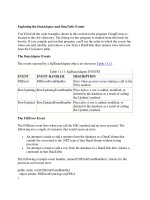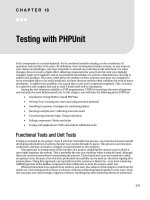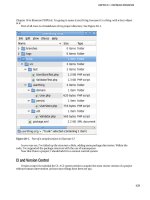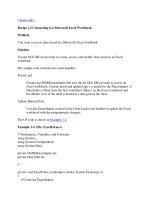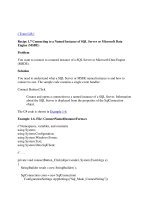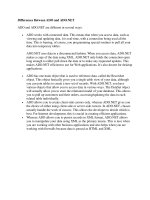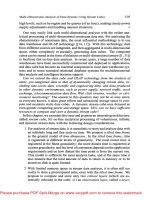Tài liệu Connecting to Access and Oracle Databases docx
Bạn đang xem bản rút gọn của tài liệu. Xem và tải ngay bản đầy đủ của tài liệu tại đây (29.01 KB, 6 trang )
Connecting to Access and Oracle Databases
In this section you'll see examples of connecting to both an Access and an Oracle
database. To interact with either of these databases in your program, you use classes from
the System.Data.OleDb namespace. This namespace contains classes for use with
databases that support object linking and embedding for databases (OLE DB) such as
Access or Oracle. You'll learn more about the System.Data.OleDb namespace in Chapter
5, "Overview of the ADO.NET Classes."
Connecting to an Access Database
You connect to an Access database using an OleDbConnection object-rather than a
SqlConnection object-with a connection string of the following format:
provider=Microsoft.Jet.OLEDB.4.0;data source=databaseFile
where databaseFile is the directory and filename of your Access database. Notice that
you specify the provider in the connection string, which is set to
Microsoft.Jet.OLEDB.4.0.
The following example creates a string named connectionString with the appropriate
format to connect to the Access Northwind database stored in the Northwind.mdb file:
string connectionString =
"provider=Microsoft.Jet.OLEDB.4.0;" +
"data source=F:\\Program Files\\Microsoft
Office\\Office\\Samples\\Northwind.mdb";
Note Notice the use of two backslash characters in the data source part of the connection
string. The first backslash is used to specify that the second backslash is to be
treated literally; therefore \\ is treated as \ in the connection string. You'll need to
locate the Northwind.mdb file on your hard disk and set your connection string
appropriately.
Assuming the System.Data.OleDb namespace has been imported, the following example
creates an OleDbConnection object, passing connectionString (set in the previous line of
code) to the constructor:
OleDbConnection myOleDbConnection =
new 01eDbConnection(connectionString);
Listing 1.2 illustrates how to connect to the Northwind Access database using an
OleDbConnection object and retrieve a row from the Customers table. Notice that you
use an OleDbCommand and OleDbDataReader object to run a SQL statement and read
the returned results from an Access database.
Listing 1.2: OLEDBCONNECTIONACCESS.CS
/*
OleDbConnectionAccess.cs illustrates how to use an
OleDbConnection object to connect to an Access database
*/
using System;
using System.Data;
using System.Data.OleDb;
class OleDbConnectionAccess
{
public static void Main()
{
// formulate a string containing the details of the
// database connection
string connectionString =
"provider=Microsoft.Jet.OLEDB.4.0;" +
"data source=F:\\Program Files\\Microsoft
Office\\Office\\Samples\\Northwind.mdb";
// create an OleDbConnection object to connect to the
// database, passing the connection string to the constructor
OleDbConnection myOleDbConnection =
new OleDbConnection(connectionString);
// create an OleDbCommand object
OleDbCommand myOleDbCommand = myOleDbConnection.CreateCommand();
// set the CommandText property of the OleDbCommand object to
// a SQL SELECT statement that retrieves a row from the Customers table
myOleDbCommand.CommandText =
"SELECT CustomerID, CompanyName, ContactName, Address "+
"FROM Customers "+
"WHERE CustomerID = 'ALFKI'";
// open the database connection using the
// Open() method of the OleDbConnection object
myOleDbConnection.Open();
// create an OleDbDataReader object and call the ExecuteReader()
// method of the OleDbCommand object to run the SELECT statement
OleDbDataReader myOleDbDataReader = myOleDbCommand.ExecuteReader();
// read the row from the OleDbDataReader object using
// the Read() method
myOleDbDataReader.Read();
// display the column values
Console.WriteLine("myOleDbDataReader[\" CustomerID\"] = "+
myOleDbDataReader["CustomerID"]);
Console.WriteLine("myOleDbDataReader[\" CompanyName\"] = "+
myOleDbDataReader["CompanyName"]);
Console.WriteLine("myOleDbDataReader[\" ContactName\"] = "+
myOleDbDataReader["ContactName"]);
Console.WriteLine("myOleDbDataReader[\" Address\"] = "+
myOleDbDataReader["Address"]);
// close the OleDbDataReader object using the Close() method
myOleDbDataReader.Close();
// close the OleDbConnection object using the Close() method
myOleDbConnection.Close();
}
}
The output from this program is as follows:
myOleDbDataReader["CustomerID"] = ALFKI
myOleDbDataReader["CompanyName"] = Alfreds Futterkiste
myOleDbDataReader["ContactName"] = Maria Anders
myOleDbDataReader["Address"] = Obere Str. 57
Connecting to an Oracle Database
You connect to an Oracle database using an OleDbConnection object with a connection
string of the following format:
provider=MSDAORA;data source=OracleNetServiceName;user
id=username;password=password
where
•
OracleNetServiceName Specifies the Oracle Net service name for the database.
Oracle Net is a software component that allows you to connect to a database over
a network. You'll need to speak with your DBA to get the Oracle Net service
name.
•
username Specifies the name of the database user you want to connect to the
database as.
•
password Specifies the password for the database user.
The following example creates a connection string named connectionString with the
correct format to connect to an Oracle database:
string connectionString =
"provider=MSDAORA;data source=ORCL;user id=SCOTT;password=TIGER";
Note The user ID of SCOTT with a password of TIGER is the default for accessing one of
the example databases that comes with Oracle. This database contains a table called
emp that contains sample employee data.
Assuming the System.Data.OleDb namespace has been imported, the following example
creates an OleDbConnection object, passing connectionString to the constructor:
OleDbConnection myOleDbConnection =
new OleDbConnection(connectionString);
Listing 1.3
illustrates how to connect to an Oracle database using an OleDbConnection
object and retrieve a row from the emp table. Notice that you use an OleDbCommand and
OleDbDataReader object to run a SQL statement and read the returned results from an
Oracle database.
Listing 1.3: OLEDBCONNECTIONORACLE.CS
/*
OleDbConnectionOracle.cs illustrates how to use an
OleDbConnection object to connect to an Oracle database
*/
using System;
using System.Data;
using System.Data.OleDb;
class OleDbConnectionOracle
{
public static void Main()
{
// formulate a string containing the details of the
// database connection
string connectionString =
"provider=MSDAORA;data source=ORCL;user id=SCOTT;password=TIGER";
// create an OleDbConnection object to connect to the
// database, passing the connection string to the constructor
OleDbConnection myOleDbConnection =
new OleDbConnection(connectionString);
// create an OleDbCommand object
OleDbCommand myOleDbCommand = myOleDbConnection.CreateCommand();
// set the CommandText property of the OleDbCommand object to
// a SQL SELECT statement that retrieves a row from the emp table
myOleDbCommand.CommandText =
"SELECT empno, ename, sal "+
"FROM emp "+
"WHERE empno = 7369";
// open the database connection using the
// Open() method of the SqlConnection object
myOleDbConnection.Open();
// create an OleDbDataReader object and call the ExecuteReader()
// method of the OleDbCommand object to run the SELECT statement
OleDbDataReader myOleDbDataReader = myOleDbCommand.ExecuteReader();
// read the row from the OleDbDataReader object using
// the Read() method
myOleDbDataReader.Read();
// display the column values
Console.WriteLine("myOleDbDataReader[\" empno\"] = "+
myOleDbDataReader["empno"]);
Console.WriteLine("myOleDbDataReader[\" ename\"] = "+
myOleDbDataReader["ename"]);
Console.WriteLine("myOleDbDataReader[\" sal\"] = "+
myOleDbDataReader["sal"]);
// close the OleDbDataReader object using the Close() method
myOleDbDataReader.Close();


